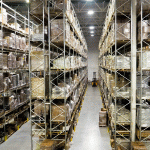The construction sector is under mounting pressure to deliver projects on time, on budget and with sustainability in mind.
Increasingly complex supply chains, rising material costs and labour shortages mean efficiency is more critical than ever.
One area undergoing rapid transformation is construction fleet management, where integrated technologies create connected jobsites and streamline supply chain operations.
Companies are reshaping how resources are moved, monitored and maintained by adopting tools like construction fleet management software and construction telematics.
The Importance of Supply Chain Management in Construction
Supply chain management in the construction industry is inherently complex. From raw materials and prefabricated components to heavy equipment and on-site logistics, multiple moving parts must align. Traditional manual coordination often leads to delays, idle equipment and budget overruns.
Construction material costs rose by over 20% in 2022, highlighting the urgent need for efficiency improvements. By integrating digital tools, organisations can better manage lead times, optimise equipment utilisation and reduce waste. This creates a more resilient and transparent supply chain that benefits contractors, clients and end users.
What Is a Connected Jobsite?
A connected jobsite integrates digital systems, people and equipment into a unified ecosystem. At its core, construction fleet management software links vehicles, machinery and tools to centralised platforms, enabling real-time decision-making. Combined with telematics — which uses GPS and onboard diagnostics to collect live data on performance, location and fuel usage — project teams gain unprecedented visibility across the jobsite.
This connected environment allows managers to:
- Track deliveries and equipment in real time.
- Automate maintenance schedules.
- Reduce downtime by predicting issues early.
- Align logistics with on-site needs more precisely.
The result is a smoother flow of materials and machinery, which directly supports effective supply chain management in construction.
Benefits of Integrated Fleet Management for Supply Chains
Integrating fleet management into construction supply chains delivers far-reaching advantages. From improving resource allocation to enhancing sustainability, these solutions strengthen project performance and create more resilient operations.
Improved Resource Allocation
Fleet tracking ensures machinery and vehicles are deployed where they are needed most. This reduces bottlenecks in supply deliveries and avoids costly idle time.
Cost Optimisation
Digital fleet tools can closely monitor and adjust fuel usage, driver performance and idle times. Fuel alone often represents 20%-30% of a vehicle’s lifetime cost, so even marginal efficiency improvements deliver significant savings.
Greater Resilience
With live data, project managers can quickly adapt to unexpected disruptions, such as delayed shipments or traffic congestion. This agility strengthens overall resilience across the construction industry’s supply chain management.
Enhanced Sustainability
Sustainability is a growing priority in the U.K. construction sector. Telematics lowers carbon emissions and supports compliance with 2050 government targets for net-zero emissions by reducing unnecessary trips, optimising routes and ensuring equipment runs efficiently.
Real-World Applications
Several U.K.-based contractors are already adopting connected jobsite solutions to improve efficiency and transparency. In highway projects, telematics coordinate heavy vehicle movements, ensuring that road closures and deliveries align precisely with planned schedules.
Modular housing schemes increasingly rely on fleet management systems to monitor just-in-time deliveries of prefabricated units, which minimises on-site storage requirements and reduces waste. Public sector projects also benefit from digital reporting’s transparency, as these systems provide auditable data on fleet usage and emissions, supporting compliance with regulatory frameworks.
Adoption is also expanding globally, with markets in Europe and North America investing heavily in construction telematics. Experts project the sector’s value will reach $11.3 billion by 2035, and the U.K. is well-positioned to benefit from aligning with these global best practices while addressing domestic challenges.
Challenges and Considerations
While benefits are clear, organisations must address several considerations:
- Data security: Protecting sensitive logistics data from cyber threats is essential.
- Training: Employees must be trained to use new systems effectively.
- Integration: Fleet management tools should connect seamlessly with existing supply chain platforms, such as procurement or inventory systems.
Construction firms can ensure a smooth transition to a connected jobsite by planning for these challenges.
The Future of Digital Transformation and Construction Supply Chains
The construction industry is undergoing a wide digital transformation, with artificial intelligence (AI), blockchain and Internet of Things technologies enhancing transparency and trust.
Industry experts estimate that AI investment in construction will exceed $4 billion by 2026, fuelling innovations like autonomous, compact vehicles capable of navigating jobsites without human input. Fleet management will be central to this evolution, serving as the data backbone that enables predictive analytics, automation, risk management and sustainability reporting.
Government policies in the U.K., such as the Construction Playbook, already encourage using digital tools to improve efficiency and value. This creates a favourable environment for companies to invest in connected fleet solutions that futureproof their supply chains.
Building Resilient Supply Chains With Connected Fleet Management
The connected jobsite is reshaping project delivery. With construction fleet management software and construction telematics, firms gain real-time visibility, stronger control and greater agility — key to enhancing supply chain management in construction.
The next step is identifying where digital fleet solutions can add the most value and integrating them into everyday operations. Taking action now ensures supply chains are ready to confidently meet future demands.
Author Bio:
Rose Morrison is an experienced writer with 10 years of experience analyzing industry trends and technological innovations. As managing editor at Renovated, she focuses on optimizing processes and improving efficiency through technology, skills directly applicable to the complexities of the IT supply chain. Rose brings her expertise to IT Supply Chain, offering insights into how strategic IT management, automation, and data analytics can streamline operations, enhance security, and drive resilience in the digital supply chain.








